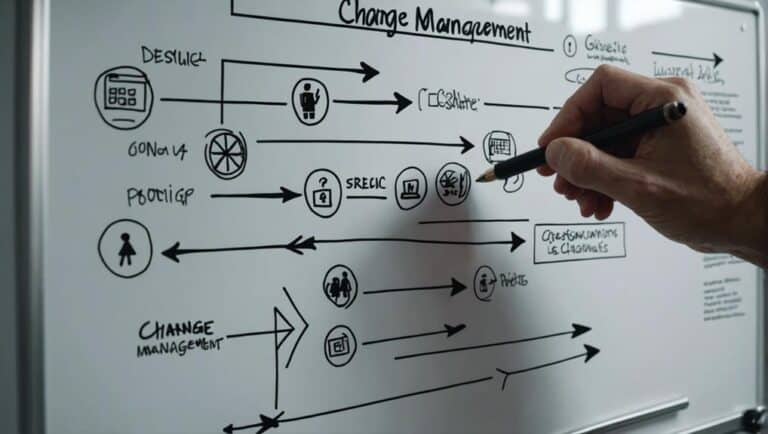As you embark on the journey of organizational change, coinciding with the need for effective change management is the pivotal aspect of measurement. How do you ensure that the changes you implement are making a tangible impact on your organization?
By understanding the importance of change measurement, you lay the groundwork for informed decision-making and strategic adjustments. Stay tuned to discover key metrics, tools, and strategies that will not only track progress but also drive continuous improvement and foster employee engagement in the process.
Key Takeaways
- Utilize quantifiable metrics for accurate change measurement.
- Implement real-time data tracking tools for immediate insights.
- Foster a culture of continuous improvement through data-driven strategies.
- Monitor employee engagement and adapt processes for successful change management.
Importance of Change Measurement
Understanding the importance of change measurement is crucial for organizations aiming to navigate and succeed through periods of transformation and growth. Measurement accuracy plays a pivotal role in assessing the effectiveness of change initiatives and determining their organizational impact. By accurately measuring the progress and outcomes of change efforts, companies can make informed decisions, identify areas for improvement, and optimize their change management strategies.
Moreover, measuring change success is essential for evaluating the overall effectiveness of organizational transformation. It allows businesses to track the achievement of objectives, identify any deviations from the desired outcomes, and implement corrective actions promptly. Additionally, ensuring stakeholder alignment through effective measurement practices is vital for securing buy-in, fostering collaboration, and sustaining momentum throughout the change journey.
Aligning stakeholders' expectations with the organization's goals and progress can significantly enhance the likelihood of successful change implementation and long-term sustainability. Therefore, prioritizing measurement accuracy and stakeholder alignment is key to driving successful change within organizations.
Key Metrics for Evaluation
You should focus on quantifiable performance indicators, real-time data tracking, and continuous improvement assessment when evaluating change management efforts.
By utilizing these key metrics, you can gauge the effectiveness of the changes implemented and make informed decisions based on real data.
This approach allows for a strategic and collaborative process that ensures ongoing success and adaptability in managing change.
Quantifiable Performance Indicators
To assess the effectiveness of change management initiatives, identifying and tracking quantifiable performance indicators is essential for evaluating the impact and success of organizational transitions. Quantifiable data allows you to measure progress objectively, providing insight into the effectiveness of the change strategies implemented.
Performance metrics such as employee engagement levels, turnover rates, productivity measures, and customer satisfaction scores can offer valuable information on how well the organization is adapting to change. By analyzing these quantifiable indicators, you can pinpoint areas that require further attention and make data-driven decisions to optimize the change management process.
Utilizing these performance metrics not only helps in gauging the success of organizational change but also enables you to adjust strategies in real-time for better outcomes.
Real-Time Data Tracking
Real-Time data tracking plays a pivotal role in evaluating the effectiveness of change management initiatives by providing immediate insights into key performance metrics for assessment.
Through real-time data analysis, organizations can swiftly identify trends, allowing for quick strategic adjustments to ensure the success of change initiatives.
This tracking method enables you to monitor progress continuously, compare actual outcomes against set targets, and implement corrective measures promptly.
By leveraging real-time data tracking, you can proactively address issues as they arise, optimize resource allocation, and enhance decision-making based on up-to-date information.
This approach fosters a collaborative environment where teams can work together to drive positive change and achieve organizational goals efficiently.
Continuous Improvement Assessment
Utilizing a comprehensive set of key metrics is essential for evaluating the effectiveness of continuous improvement initiatives within change management processes. When it comes to continuous improvement assessment, ongoing evaluation and improvement tracking play a pivotal role in ensuring that organizational changes are yielding the desired outcomes. To measure the success of these initiatives, consider the following key metrics:
- Cycle Time Reduction: Measure the time taken to complete processes before and after improvement efforts.
- Cost Savings: Track the financial impact of improvements in terms of cost reductions or efficiency gains.
- Quality Metrics: Monitor changes in quality indicators to assess the impact of improvements on product or service quality.
- Employee Engagement: Evaluate employee satisfaction and involvement in continuous improvement activities.
- Customer Satisfaction: Measure changes in customer satisfaction levels as a result of improvement initiatives.
Tools for Tracking Progress
Tracking progress effectively is essential for successful change management, enabling stakeholders to monitor and adjust strategies in real time. Utilizing progress tracking along with technology tools is crucial in ensuring the smooth implementation of organizational changes.
Technology tools like project management software, dashboards, and collaboration platforms offer real-time visibility into the status of initiatives, fostering transparency and accountability. By leveraging these tools, you can easily track performance metrics and conduct data analysis to measure the effectiveness of the change efforts.
Performance metrics such as key performance indicators (KPIs) and balanced scorecards are instrumental in quantifying progress and identifying areas that require attention. Data analysis helps in interpreting the collected data, providing valuable insights into the impact of the implemented changes.
Collaborating with team members and stakeholders to review progress tracking data fosters a shared understanding of the change process and enables informed decision-making. By utilizing technology tools for tracking progress and analyzing performance metrics, organizations can proactively address challenges and optimize their change management strategies for success.
Strategies for Improvement
You can enhance your change management process by emphasizing data-driven decision making and continuous process evaluation.
By utilizing data to drive your decisions, you can identify trends, areas for improvement, and potential roadblocks more effectively.
Continuous evaluation ensures that your strategies remain adaptive and aligned with your organizational goals.
Data-Driven Decision Making
To enhance the effectiveness of change management initiatives, implementing a structured approach to data-driven decision making is essential for achieving measurable improvements. When considering data-driven decision making, it's crucial to focus on data analysis and decision support.
Here are five strategies to improve your data-driven decision-making process:
- Establish Clear Objectives: Define specific goals to guide your data analysis efforts.
- Utilize Advanced Analytics Tools: Invest in tools that can help you gather, analyze, and interpret data effectively.
- Ensure Data Quality: Implement measures to maintain the accuracy and reliability of your data.
- Encourage Cross-Functional Collaboration: Foster teamwork between departments to gain diverse insights.
- Regularly Monitor Key Performance Indicators (KPIs): Track KPIs to measure the impact of decisions and adjust strategies accordingly.
Continuous Process Evaluation
Improving change management effectiveness can be significantly enhanced through the continuous evaluation of processes, which offers crucial insights for refinement and enhancement.
Continuous process evaluation is essential for identifying bottlenecks, inefficiencies, and areas of improvement within organizational processes. By analyzing each step of the change management process, you can pinpoint specific areas that require attention and optimization. This ongoing assessment allows for real-time adjustments, leading to enhanced organizational effectiveness.
Strategies for process improvement should focus on streamlining workflows, enhancing communication channels, and fostering a culture of adaptability. By prioritizing continuous process evaluation, organizations can proactively address challenges, capitalize on opportunities, and drive sustainable change within their operations.
Embracing a mindset of constant improvement is key to achieving long-term success in change management.
Employee Engagement in Measurement
Amid the process of change management measurement, engaging employees in the measurement process is pivotal to fostering a culture of transparency and accountability within the organization. Employee engagement in measurement not only provides valuable insights but also empowers individuals, making them feel like active participants in the change process.
Here are some key strategies to enhance employee engagement in measurement:
- Regular Communication: Ensuring open and clear communication channels about the measurement process.
- Training Programs: Providing training on how to effectively participate in survey analysis and feedback collection.
- Recognition: Acknowledging and appreciating employee contributions to the measurement process.
- Involvement in Action Planning: Involving employees in creating action plans based on measurement outcomes.
- Feedback Mechanisms: Establishing mechanisms for employees to provide feedback on the measurement process itself.
Continuous Monitoring and Adaptation
For effective change management, continuously monitoring and adapting strategies is essential to ensure alignment with evolving circumstances and goals. Adaptive strategies allow organizations to respond promptly to changes, making proactive monitoring a crucial component of successful change initiatives. By constantly evaluating the progress and impact of implemented changes, you can identify potential roadblocks early on and adjust strategies accordingly. This proactive approach enables you to stay ahead of potential issues and swiftly pivot towards more effective solutions.
Incorporating adaptive strategies into your change management process fosters a culture of flexibility and innovation within your organization. It encourages employees to embrace change as a natural part of the organizational evolution, leading to smoother transitions and higher levels of engagement. By consistently monitoring the effectiveness of your change efforts and adapting strategies as needed, you demonstrate a commitment to continuous improvement and agility in the face of shifting circumstances. Embracing proactive monitoring and adaptive strategies positions your organization for long-term success in navigating complex and dynamic environments.
Frequently Asked Questions
How Can Organizational Culture Impact the Effectiveness of Change Measurement in Change Management Processes?
When considering organizational culture's influence on change effectiveness, it's crucial to evaluate how values, norms, and communication impact measurement. Aligning metrics with cultural aspects fosters understanding, engagement, and adaptability, enhancing the overall success of change management initiatives.
Are There Any Ethical Considerations to Keep in Mind When Measuring Organizational Change?
When measuring organizational change, ethical considerations are crucial. Stakeholder engagement is key to ensure transparency and fairness. By involving all parties, you uphold integrity, build trust, and mitigate potential conflicts. Prioritize ethical standards in your change measurement processes.
What Are Some Common Challenges Organizations Face When Trying to Improve Their Change Measurement Strategies?
When improving change measurement strategies, organizations commonly face challenges such as aligning performance metrics with goals, ensuring employee engagement, and overcoming resistance to change. It's crucial to address these hurdles strategically for successful implementation.
How Can Technology Play a Role in Enhancing the Accuracy and Efficiency of Change Measurement in Organizations?
To enhance accuracy and efficiency in change measurement, technology integration is key. Utilize data analytics tools to track and analyze progress effectively. This strategic approach helps you make informed decisions and adapt swiftly in navigating organizational changes.
What Are Some Best Practices for Effectively Communicating Change Measurement Results to Stakeholders Within an Organization?
When communicating change measurement results to stakeholders in your organization, emphasize engagement through clear data visualization. Utilize reporting tools to craft compelling narratives that highlight progress and impact, fostering buy-in and support for ongoing initiatives.
Conclusion
In conclusion, measuring organizational change is like navigating a ship through rough waters. By using key metrics, tracking tools, and engaging employees, you can steer the ship towards success.
Continuous monitoring and adaptation are like adjusting the sails to catch the wind, ensuring that you stay on course. With a strategic approach and collaborative effort, change management becomes a smoother journey towards achieving your organizational goals.
Stay focused, stay agile, and watch your organization thrive amidst change.





